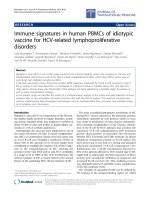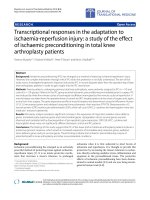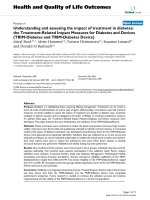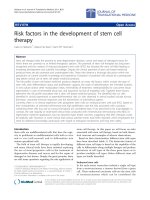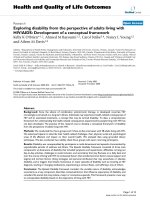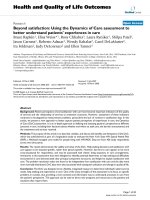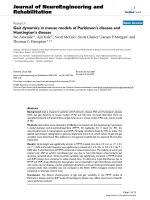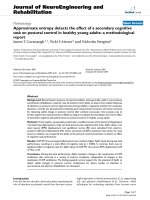báo cáo hóa học:" Confronting TB/HIV in the era of increasing anti-TB drug resistance" pdf
Bạn đang xem bản rút gọn của tài liệu. Xem và tải ngay bản đầy đủ của tài liệu tại đây (236.3 KB, 6 trang )
BioMed Central
Page 1 of 6
(page number not for citation purposes)
Journal of the International AIDS
Society
Open Access
Review
Confronting TB/HIV in the era of increasing anti-TB drug resistance
Jeremiah Chakaya*
1
, Haileyesus Getahun
2
, Reuben Granich
3
and
Diane Havlir
4
Address:
1
Centre for Respiratory Diseases Research, Kenya Medical Research Institute, Africa,
2
Stop TB Department, World Health Organization,
Geneva, Switzerland,
3
HIV Department, World Health Organization, Geneva, Switzerland and
4
University of California, San Francisco, USA
Email: Jeremiah Chakaya* - ; Haileyesus Getahun - ; Reuben Granich - ;
Diane Havlir -
* Corresponding author
Abstract
HIV associated TB is a major public health problem. In 2006, it was estimated that there were over
700,000 people who suffered from HIV associated TB, of whom about 200, 000 have died. The
burden of HIV associated TB is greatest in Sub-Saharan Africa where the TB epidemic is primarily
driven by HIV. There has been steady progress made in reducing the burden of HIV in TB patients
with an increasing number of TB patients tested for HIV and provided with cotrimoxazole
preventive therapy (CPT) and anti-retroviral treatment (ART). Less progress is being made to
reduce the burden of TB in people living with HIV. The number of HIV infected persons reported
to have been screened for TB was less than 1% while Isoniazid preventive therapy was reported to
have been provided to less than 0.1% of eligible persons in 2006. A major push is urgently needed
to accelerate the implementation of three important interventions. The three are Intensified TB
Screening (ICF) among people living with HIV, the provision of Isoniazid Preventive Therapy (IPT)
and TB Infection Control(IC). These interventions are best carried out by HIV control programmes
which should therefore be encouraged to take greater responsibility in implementing these
interventions.
Burden of HIV associated TB
It is estimated that two thirds of the world population, or
nearly two billion people, is infected with the tuberculosis
bacillus[1] while about 33 million people were living
with HIV by the end of 2007[2]. The convergence of the
two epidemics affects about 11 million people. Tubercu-
losis is the most common HIV related infection and the
most common cause of death in HIV infected persons.
The HIV epidemic is the major factor responsible for the
dramatic increase in TB incidence that has been witnessed
in Sub-Saharan Africa over the last decade [3]. Even
though Sub -Saharan Africa, with about 85% of the esti-
mated 709,000 HIV associated TB infections in 2006,
bears the brunt of TB/HIV, other "hot spots" for HIV asso-
ciated TB include India and Brazil, which had 3.3% and
1% of the global burden respectively in 2006[1]. The TB
and HIV epidemics are so intricately intertwined in Sub-
Saharan Africa that the prevention and care of one must
be linked with the prevention and care of the other [4].
HIV influences TB by increasing the risk of reactivation of
latent TB infection, rapid progression of new TB infection
to disease and recurrent disease from both re-infection
and relapse [5]. Other than for differences in magnitude,
TB is the most common opportunistic infection that is
observed in the first three months of initiation of com-
Published: 6 November 2008
Journal of the International AIDS Society 2008, 11:6 doi:10.1186/1758-2652-11-6
Received: 19 August 2008
Accepted: 6 November 2008
This article is available from: />© 2008 Chakaya et al; licensee BioMed Central Ltd.
This is an Open Access article distributed under the terms of the Creative Commons Attribution License ( />),
which permits unrestricted use, distribution, and reproduction in any medium, provided the original work is properly cited.
Journal of the International AIDS Society 2008, 11:6 />Page 2 of 6
(page number not for citation purposes)
bined ART in both Sub-Saharan Africa and the industrial-
ized world of North America and Europe [6,7].
Tuberculosis threatens the gains being made in the provi-
sion of ART to people living with HIV.
Interventions for HIV associated TB
In 2004 the World Health Organization published the
interim policy for TB/HIV collaborative activities, a com-
prehensive guide for the implementation of TB/HIV col-
laborative activities, which highlights twelve key activities
whose full implementation is expected to lead to a signif-
icant impact on the burden of TB/HIV [8]. Since the pub-
lication of this document significant progress has been
made regarding the establishment of mechanisms for col-
laboration and the reduction of the burden of HIV in TB
patients. For example HIV testing of TB patients increased
from 21,806, less than 1% of all notified cases, in 9 coun-
tries in 2002 to 687,174 patients, 12% of all notified
cases, from 112 countries in 2006. In Africa 287, 945
patients (22% of all notified cases) were tested for HIV in
2006. Of the 186, 217 HIV infected TB patients detected
in 2006, 146, 586 (78%) were placed on CPT and
66,601(41%) on ART [1]. In most countries CPT is largely
provided at TB clinics while ART provision often implies
referral from TB clinics to ART sites, leading to loss of
patients and partly accounting for the low uptake of ART
in HIV infected TB patients.
Although there is much work to be done to provide HIV
counseling and testing to all TB patients, a number of
countries have had exemplary performance in getting TB
patients tested for HIV. These countries include Rwanda,
Brazil, Malawi, Kenya and Botswana who achieved testing
rates of more than 60% of notified TB cases by the end of
2006[1].
Some of the factors that have contributed to this perform-
ance include the establishment of appropriate national
policies and guidelines, revision and/or adoption of new
recording and reporting tools that are able to capture TB/
HIV indicators, target setting at all levels of the health care
system, appropriate financing and training, support of
health care workers and providing services under one roof
(table 1) [9,10]. These factors are greatly enhanced by
stronger communication and collaboration between the
TB and HIV control programmes.
There has been less robust progress with activities
intended to reduce the burden of TB in persons living with
HIV. In 2006 only 0.9% of the estimated 33 million HIV
positive people were screened for TB. Of the 314,934 HIV
infected persons reported to have undergone screening for
TB in 2006, 84,713 (27%) were found to have TB, imply-
ing a high yield of TB screening programmes for HIV
infected persons. Only 0.1% (27,056 of 33 million HIV
infected persons) of HIV infected persons were reported to
have received Isoniazid Preventive Therapy in 2006. Of
the 27,056 provided with IPT, 70% were in Botswana, the
only country with a nationwide IPT programme [1].
While non-reporting or underreporting may be responsi-
ble for this rather grim scenario, there is real concern that
not enough is being done to reduce the burden of TB in
persons living with HIV.
To stimulate and accelerate action in this area WHO, and
more specifically the HIV department of WHO, coined the
term the 'Three I's' for Isoniazid Preventive Therapy (IPT),
Intensified TB Case Finding (ICF) and TB infection Con-
trol (IC). In April 2008, WHO organized the 'Three I's'
meeting where it was recognized that these three key inter-
ventions should be central to the scale-up of care and ART,
given the threat posed by TB.
Table 1: What is needed for nationwide scale up of TB/HIV Collaborative Activities
National policies and guidelines
Recording and Reporting tools
Collaboration and communication between TB and HIV control programmes
Leadership and commitment
Target setting at all levels of the health care system
Human resources: recruitment, training, support, task shifting
Financing
National Partnerships for results
Providing TB and HIV services under one roof
Journal of the International AIDS Society 2008, 11:6 />Page 3 of 6
(page number not for citation purposes)
Isoniazid preventive therapy
Several randomized clinical trials have demonstrated that
TB can be effectively prevented using Isoniazid for 6–12
months in HIV negative persons [11]. As the HIV epi-
demic unfolded and TB was recognized to be a major
problem in HIV infected persons, a series of studies
designed to test the efficacy of Isoniazid in preventing HIV
associated TB were carried out. The effects were similar to
what had been observed in HIV non-infected persons. The
incidence of HIV associated TB could be effectively
reduced but IPT had no impact on all cause mortality. The
beneficial effect of IPT was associated with only a slight
increase in adverse drug effects. The protective effect
diminishes with time and lasts one to three years on aver-
age [12]. While IPT has been found to have no effect on
mortality of HIV infected adults, a South African study
documented a significant effect on mortality of HIV
infected children and the placebo arm of this study had to
be prematurely terminated [13].
Having established the efficacy of IPT in preventing HIV
associated TB, the TB community moved on to document
feasibility of this intervention under "routine" pro-
gramme conditions. The results were somewhat disap-
pointing with high attrition rates and low treatment
completion rates [14,15].
Despite the documented efficacy and feasibility of IPT for
the prevention of HIV associated TB, this intervention has
not yet been taken up on a large scale. This was probably
the result of policy uncertainties as the earlier message by
technical agencies including WHO only promoted TB pre-
ventive therapy for "personal protection" as opposed to a
public health intervention designed to impact on the
community incidence of TB. Additionally there were fears
that TB preventive therapy programmes could expand Iso-
niazid resistance because of difficulties in confidently
excluding active TB. There were also concerns about
safety. The non involvement of HIV control programmes
and communities, including the community of HIV
infected persons, may also have contributed to the low
uptake of this intervention.
Although IPT targets HIV infected persons who are not
suffering from TB and are therefore not in TB control pro-
grammes, there were uncertainties over which pro-
gramme, between the TB and HIV control programmes,
should be responsible for this intervention. It is therefore
not surprising that to date only Botswana has a country-
wide TB preventive therapy programme which is nested
within the TB control programme. The landscape has,
however, completely changed since the time that the IPT
feasibility studies were undertaken. There is a new push
for IPT and greater engagement of HIV control pro-
grammes coupled with HIV activism in favor of IPT which
is expected to lead to some progress in the provision of
IPT. There is a very urgent need however for the develop-
ment of appropriate recording and reporting tools to
allow for the routine collection, collation and analysis of
data related to the provision of IPT. We are hoping that
these will form part of the pre-ART care register and be
central to recording and reporting on HIV care delivery
within HIV services.
Anti-retroviral therapy and IPT
With the advent of combined ART it was observed that TB
incidence fell in persons on ART in North America and
Europe. The fall in TB incidence has been observed to be
greater in persons with a higher baseline CD4 T cell count,
a lower base line viral load and robust immunological
and virological responses [16]. Similar observations have
been made in South Africa [17]. Questions have therefore
been raised about the added value of IPT in preventing TB
in persons receiving ART. A recent retrospective study car-
ried out in Rio D Janeiro, Brazil, suggests that the combi-
nation of ART and IPT has the greatest impact on TB
incidence when compared to IPT or ART alone[18] and
provides further impetus to provide IPT in all HIV infected
persons irrespective of whether they are or are not on ART.
This approach would conform with the observation that
the risk of TB in HIV infected persons remains higher than
that in non-HIV infected persons even when on ART[19].
IPT and the risk of drug resistant TB
The recent outbreaks of MDR and XDR TB have reinforced
the fear of expansion of isoniazid resistance. Expansion of
Isoniazid resistance could lead to the emergence of MDR
and XDR TB in places where these forms of TB are not cur-
rently a major problem. The need for IPT is currently
greatest in countries that have the least capacity to deal
with MDR and XDR TB. Although data on the impact of
IPT on Isoniazid resistance is scanty and suggests that in
the short term expansion of Isoniazid resistance may not
be a major outcome of IPT [20], some modeling studies
suggest that the widespread use of IPT as a public health
intervention will reduce the incidence of tuberculosis in
the short term but also will speed up the development of
drug resistant TB [21]. It is therefore critical that the roll
out of IPT programmes is carefully monitored for effec-
tiveness and impact on isoniazid resistance.
Intensified TB case finding
When screened for TB up to 25% of people living with
HIV will have prevalent TB and an additional 11% will
have incident TB. Persons initiating ART who develop TB
have an increased risk of death which may reach 15–20%.
The intensification of TB case finding through screening is
likely to improve the safety of ART initiation and may
improve the uptake of IPT [22]. Screening programmes
have, however, varied and include symptom and sign
Journal of the International AIDS Society 2008, 11:6 />Page 4 of 6
(page number not for citation purposes)
screening, chest x-ray, sputum examination (for both
smear microscopy and TB culture) and tests for latent TB
such as the tuberculin skin test and or the interferon
gamma release assays. In most situations screening tools
appear to target pulmonary TB and may be unsuitable for
use in children and for extrapulmonary forms of TB. There
is a need for some standardization of TB screening tools
which incorporate the most sensitive and specific constel-
lation of symptoms, signs and tests for all forms of TB in
all age groups. Regardless of algorithm, TB screening is
vital. Tuberculosis is curable and linking persons living
with HIV to TB diagnosis and DOTS-based treatment is
potentially life saving for the individual and also an
important public health measure.
TB infection control
The places where people living with HIV receive care and
treatment, including non medical care such as counseling
centres and support group meeting places, may pose sub-
stantial risk for the transmission of TB. In poor countries
of Sub-Saharan Africa hospitals wards and clinics may be
very congested and can be fertile grounds for TB transmis-
sion. It is essential that simple but effective measures for
preventing TB transmission in health care and other con-
gregate settings are put in place especially now that MDR
and XDR TB are increasingly becoming major concerns.
Although TB Infection control guidelines for resource lim-
ited settings have been in place since 1999[23,24], WHO
has recently developed 10 infection control actions with
the slogan 'Safety without Stigma' that are intended to
simplify TB infection control and also to reduce unwar-
ranted stigma that may inadvertently be a consequence of
TB infection procedures. Thus community engagement
has been identified to be an essential first step in the
development and implementation of an infection control
plan (Table 2). It is anticipated that the approach advo-
cated by WHO will reduce the hierarchical confusion that
is at times observed in countries where health care work-
ers demand state of the art technologies for infection con-
trol while ignoring basic administrative procedures such
as prompt identification and diagnosis of potentially
infectious patients. It will be essential to develop a set of
key outcome indicators that infection control implement-
ers can monitor to determine the effectiveness of the
measures put in place.
Challenges to TB/HIV care
Initiating ART in HIV infected TB patients
The clinical care of HIV infected TB patients and in partic-
ular the treatment of these persons with life saving anti-
retroviral medications is constrained by a number of fac-
tors. The provision of ART to HIV infected TB patients is
intended to prevent further morbidity, mortality and to
improve quality life. If ART is delayed patients may die
before treatment is provided. Yet at the same time if treat-
ment is given early during TB treatment, issues of pill bur-
den, co-toxicities, the immune reconstitution
inflammatory syndrome (IRIS) and pharmacokinetic
interactions may contribute to morbidity or even mortal-
ity and render this therapy ineffective.
In Malawi it has been documented that the initiation of
ART after the two months intensive phase of anti-TB treat-
ment, as recommended by the ART programme in that
country, did not decrease the unacceptably high mortality
of HIV infected TB patients during the TB treatment [25].
However early initiation of ART within the first one
month of anti-TB treatment may be a risk factor for TB-
IRIS [26]. Although the majority of patients who experi-
ence TB-IRIS have mild disease, some episodes can be
severe and end fatally. TB-IRIS therefore has implications
for the way care is organized and demands robust referral
systems. Ongoing studies examining the issue of optimal
timing of ART initiation are expected to shed light on this
important issue. Current clinical experience however sug-
gests that ART should not be delayed on account of avoid-
ing IRIS.
Anti-TB drug induced hepatitis (DIH)
It is known that populations at risk for HIV and TB are
also at risk for hepatitis B and or C infection. These
hepatic infections may influence the risk of drug induced
hepatis (DIC). HIV has been found to be an independent
risk factor for DIH [27,28] which may be augmented by
hepatitis C but not hepatitis B [29]. These hepatic reac-
tions, although relatively uncommon, may complicate
the provision of appropriate care for HIV infected TB
patients leading to greater health resource utilization and
a greater demand for secondary or tertiary level care. The
Table 2: Ten essential actions for TB infection control
Involve community
Develop infection control plan
Safe sputum collection
Cough hygiene
Triage TB suspects
Rapid diagnosis and treatment
Improve ventilation
Protect Health care workers
Capacity building
Monitor infection control practices
Journal of the International AIDS Society 2008, 11:6 />Page 5 of 6
(page number not for citation purposes)
weak health care systems in the settings where the TB/HIV
disease burden is greatest may find this a tough issue to
cope with.
New threats to TB/HIV care
Multi and extensive drug resistant TB and HIV
Unfortunately the progress being made in providing care
and treatment to HIV infected TB patients is being threat-
ened by the emergence of drug resistant TB and in partic-
ular multi and extensive drug resistant TB. On World Stop
Day, 2006, the United States Centres for Disease Control
and Prevention (CDC) published in the Morbidity and
Mortality Weekly Report, a report that indicated the pres-
ence of extensive drug resistant TB (TB bacilli resistant to
a fluroquinolone and one of the second line injectable
drugs in addition to resistance to rifampicin and isoni-
azid) in virtually all regions of the world [30]. Of the
17,690 TB isolates examined between 2000–2004 from a
network of international reference laboratories, 20% were
MDR and 2% were XDR. Additionally it was reported that
of the TB isolates from the United States (for 1993–2004),
Latvia (for 2000–2002), and South Korea (for 2004), 4%,
19%, and 15% of MDR TB cases, respectively, were XDR.
This report was followed soon after by a disturbing report
from Kwa Zulu Natal in South Africa. In the Kwa Zulu
report, it was reported that of 542 patients with culture
positive TB, 221(41%) had MDRTB. Of the 221 patients
with MDRTB 53(24%) had XDRTB. Of the 53 patients
with XDRTB, 52 (98%) died in a median 16 days after
sputum collection. All 44 patients with XDR TB tested for
HIV were HIV positive. From genotyping data the XDR TB
isolates were found to be related and suggested common
sources of infection. Over half of the patients had not
been treated for TB previously and nearly two thirds of
them had been admitted to hospital in the last two years
[31]. This suggested that there was significant transmis-
sion of MDR and XDR TB and that the transmission was
probably taking place in the hospital setting. The issue of
infection control was sharply brought into focus as was
the vulnerability of the HIV infected person to acquiring
drug resistant TB at health care and other congregate set-
tings and to progress rapidly to fatal disease. Institutional
outbreaks of drug resistant TB affecting HIV infected per-
sons are, however, not a new phenomenon. In the eighties
and nineties such outbreaks were reported from several
hospitals in the industrialized world. These outbreaks
were associated with high mortality exceeding 70% [32].
The observed link between HIV and drug resistant TB is
also not limited to Sub-Saharan Africa. Countries of the
former Soviet Union have the highest rates of drug resist-
ant TB and some of that resistance is associated with HIV
[33]
In February this year, WHO released the fourth global
drug resistance report which highlights the growing prob-
lem of anti-TB drug resistance. Among new cases any
resistance was estimated at 17.0% (95 CLs 13.6–20.4),
Isoniazid resistance at 10.3% (95% CLs 8.4–12.1) and
MDR TB at 2.9 (95% CLs 2.2–3.6). In previously treated
cases any resistance was estimated at 35.0% (95 CLs 24.1–
45.8), Isoniazid resistance at 27.7% (95% CLs 18.7–36.7)
and MDR TB at 15.3% (95% CLs 9.6–21.1). The global
estimate is that is that there were 489,139 (95% CLs
455,093–614, 215) incident cases of MDR TB in 2006. As
for XDR-TB, 45 countries have reported at least one case
[34].
Drug resistant TB is a man made problem and is primarily
a consequence of sub optimal TB control. Drug resistant
TB has brought to the fore key challenges to TB care and
prevention. These difficult to treat forms of TB are calling
for the finding, as a matter of urgency, of new medicines
that work and new and rapid diagnostics for both suscep-
tible and drug resistant TB. Drug resistant TB has also
brought to the fore ethical challenges such as the justifica-
tion of isolation to protect communities without violating
individual rights and the appropriateness of Direct Obser-
vation of Drug Intake (DOT) to ensure all anti-drug doses
are ingested [35].
Prevention remains the best strategy and therefore the
strengthening of TB control programmes to achieve high
TB case finding and treatment success cannot be overem-
phasized. Closely linked to this is the institution of sim-
ple, affordable and effective measures to prevent TB
transmission in health care and other congregate settings.
We conclude by emphasizing that TB/HIV is a major pub-
lic health concern which demands a greater effort from TB
and HIV prevention and care programmes, multinational
technical agencies, financiers, researchers, communities
and others. The added effort should see more rapid
progress made in decreasing the burden of HIV in TB
patients (testing, CPT and ART) and the burden of TB in
PLHIV. Tuberculosis is appropriately gaining increasing
importance to the HIV community. The 'Three I's' have
also gained increasing importance among major opinion
leaders. It is increasingly being recognized that if the HIV
community does not own and provide leadership in the
implementation of the 'Three I's', it is likely that TB will
continue to be the number one killer of persons living
with HIV and a persistent threat to the gains being made
in improving access to HIV care and treatment.
Acknowledgements
Jeremiah Chakaya prepared the first draft of the presentation at the XVII
International AIDS conference and the first draft of this manuscript with the
assistance of Haileyesus Getahun. Reuben Granich and Diane Havlir
reviewed the presentation and this manuscript and provided further inputs.
Publish with BioMed Central and every
scientist can read your work free of charge
"BioMed Central will be the most significant development for
disseminating the results of biomedical research in our lifetime."
Sir Paul Nurse, Cancer Research UK
Your research papers will be:
available free of charge to the entire biomedical community
peer reviewed and published immediately upon acceptance
cited in PubMed and archived on PubMed Central
yours — you keep the copyright
Submit your manuscript here:
/>BioMedcentral
Journal of the International AIDS Society 2008, 11:6 />Page 6 of 6
(page number not for citation purposes)
Dr. Pedro Kahn of the International AIDS Society is acknowledged for pro-
viding useful comments during the early phases of the preparation of this
manuscript. The manuscript is published with the permission of the Direc-
tor, Kenya Medical Research Institute.
References
1. Global Tuberculosis Control: Surveillance, planning and financ-
ing. WHO Report 2008. WHO/HTM/TB/2008.293
2. UNAIDS: AIDS epidemic update: December 2007. UNAIDS/07.27E/
JC1322 .
3. Chaisson Richard E, Martinson Neil: Tuberculsosis in Africa –
Combating an HIV driven crisis. NEJM 2008,
358(11):1089-1092.
4. De Cock KM, Chairsson RE: Will DOTS do it? A reappraisal of
tuberculosis control in countries with high rates of HIV infec-
tion. Int J Tuberc Lung Dis 1999, 3:457-465.
5. Harries AD: Tuberculosis and human immunodeficiency
infection in developing countries. Lancet 1990, 335:387-390.
6. The changing incidence of AIDS events in patients receiving
highly active antiretroviral therapy. The antiretroviral therapy
collaboration. Arch Intern Med 2005, 165:416-423.
7. Grabar S, Lanoy E, Allavena C, Mary-Krause M, Bentata M, Fischer P,
Mahamat A, Rabaud C, Costagliola D, on behalf of the Clinical Epide-
miology Group of the French Hospital Database on HIV: Causes of
the first AIDS-defining illness and subsequent survival before
and after the advent of combined antiretroviral therapy. HIV
Med 2008, 9(4):246-256.
8. World Health Organization: Interim policy on collaborative TB-
HIV activities. Geneva, Switzerland: WHO; 2004. WHO/HTM/
TB/2004.330;WHO/HTM/HIV2004.1
9. Corneli A, Jarrett NM, Sabue M, et al.: Patient and provider per-
spectives on implementation models of HIV counseling and
testing for patients with TB. Int J Tuberc Lung Dis 2008, 12(3
Suppl 1):79-84.
10. Chakaya JM, Mansoer JR, Scano F, et al.: National scale-up of HIV
testing and provision of HIV care to tuberculosis patients in
Kenya. Int J Tuberc Lung Dis 2008, 12(4):424-9.
11. Smieja MJ, Marchetti CA, Cook DJ, Small FM: Isoniazid for pre-
venting tuberculosis in non-HIV infected persons(Review).
Cochrane Database of Systematic Reviews 1999:CD 001363. DOI:
10.1002/14651858.CD 001363
12. Woldehanna S, Volmink J: Treatment of latent tuberculosis
infection in HIV infected persons(Review). Cochrane Database
of Systematic Reviews 2004:CD 000171. DOI:10. 1002/
14651858.CD000172.pub2
13. Zar Heather J, Cotton Mark F, Strauss Stanzi, et al.: Effect of Isoni-
azid prophylaxis on mortality and incidence of tuberculosis
in children with HIV: randomized controlled trial. BMJ 2007,
334:136.
14. Aisu T, Raviglione MC, van Praag E, Eriki P, Narain JP, Barugahare L,
Tembo G, McFarland D, Engwau FA: Preventive chemotherapy
for HIV associated tuberculosis in Uganda: an operational
assessment at a voluntary counseling and testing centre.
AIDS 1995, 9(3):263-73.
15. Mugisha B, Bock N, Mermin J, Odeke RM, Miller B, Adatu-Engwau F,
Granich R, Bunnell R: Tuberculosis case finding and preventive
therapy in an HIV voluntary counseling and testing centre in
Uganda. Int J Tuberc Lung Dis 2006, 10(7):761-767.
16. Girardi Enrico, Sabin Caroline A, Montarte Antonell d' Amino, et al.:
Incidence of tuberculosis among HIV infected patients
receiving highly active antiretroviral therapy in Europe and
North America. Clinical Infectious Diseases 2005, 41:1772-82.
17. Badri M, Wilson D, Wood R: Effect of highly active anti-retrovi-
ral therapy on the incidence of tuberculosis in South Africa:
a cohort study. Lancet 2002, 359(9323):2059-2064.
18. Golub Jonathan E, Saracen Valeria, Covalcante Solange C, et al.: The
impact of antiretroviral therapy and Isoniazid preventive
therapy on tuberculosis incidence in HIV infected patients in
Rio de Janeiro, Brazil. AIDS 2007, 21:1441-144.
19. Havlir Diane V, Getahun Haileyesus, Sanne Ian, et al.: Oppurtunities
and challenges in overlapping HIV and TB epidemics. JAMA
2008, 300(4):423-430.
20. Balcells ME, Thomas SL, Godfrey-Faussett P, Grant AD: Isoniazid
preventive therapy and risk for resistant tuberculosis.
Emerg
Infect Dis 2006, 12(5):744-51.
21. Cohen T, Lipsitch M, Walensky RP, Murray M: Beneficial and per-
verse effects of Isoniazid preventive therapy for latent tuber-
culosis infection in HIV-tuberculosis co-infected populations.
Proc Natl Acad Sci USA 2006, 103(18):7042-7.
22. Lawn Stephen D, Landon Myer, Linda-Gail Bekker, Wood Robin:
Burden of tuberculosis in an antiretroviral treatment pro-
gramme in sub-Saharan Africa: impact on treatment out-
comes and implications for tuberculosis control. AIDS 2006,
20:1605-1612.
23. Guidelines for the prevention of tuberculosis in health care
facilities in resource-limited settings. WHO, Geneva; 1999.
WHO/CDS/TB/99.269
24. Tuberculosis infection control in the era of expanding HIV
care and treatment – Addendum to WHO Guidelines for the
prevention of tuberculosis in health care facilities in
resource-limited settings. World Health Organization, Geneva;
2007. WHO/HTM/TB/99.269
25. Zachariah R, Fitzgerald M, Massaquoi M, et al.: Does antiretroviral
treatment reduce case fatality among HIV positive patients
with tuberculosis in Malawi. Int J Tuberc Lung Dis 2007,
11:848-853.
26. Lawn Stephen D, Myer Landon, Bekker Linda-Gail, Wood Robin:
Tuberculosis associated immune reconstitution disease:
incidence, risk factors and impact in an antiretroviral treat-
ment service in South Africa. AIDS 2007, 21:335-341.
27. Ozick LA, Jacob L, Comer GM, et al.: Hepatotoxicity from Isoni-
azid and rifampicin in inner city AIDS patients. Am J Gastroen-
tol 1995, 90:1978-1980.
28. Yimer Getnet, Aderaye Getachew, Amogne Wondwossen, et al.:
Anti-Tuberculosis therapy induced hepatotoxicity among
Ethiopian HIV positive and negative patients. PLoSONE
3(3):e1809. doi.10.1371/journal.pone.0001809
29. Padmapriyadarsini C, Chandrabase J, Victor L, Hanna LE, Arunkumar
N, Swaminathan S: Hepatitis B or hepatitis C co-infection in
individuals infected virus and effect of anti-tuberculous drugs
on liver function. J Postgrad Med 2006, 52:92-6.
30. MMWR:
55:11. 2006, March 24
31. Gandhi NR, Moll A, Sturm AW, et al.: Extensively drug-resistant
tuberculosis as a cause of death in patients co-infected with
tuberculosis and HIV in a rural area of South Africa. Lancet
368(9547):1575-80. 2006 Nov 4
32. Wells Charles D, Peter Cegielski J, Nelson Lisa J, et al.: HIV Infec-
tion and Multi drug resistant tuberculosis – the perfect
storm. Journal of Infectious Diseases 2007, 196:S86-107.
33. Dubrovina I, Miskinis K, Lyepshina S, et al.: Drug resistant tubercu-
losis and HIV in Ukraine: a threatening convergence of two
epidemics. Int J Tuberc Lung Dis 2008, 12(7):758-762.
34. Anti-Tuberculosis Drug Resistance in the world Report No
4. The WHO/IUATLD Global project on anti-tuberculosis drug resistance
surveillance . WHO/HTM/TB/2008.394
35. Koenig R: Drug-resistant tuberculosis. In South Africa, XDR
TB and HIV prove a deadly combination. Science
319(5865):894-7. 2008 Feb 15
